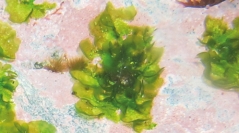

 Cryptogamie, Algologie
42 (9) - Pages 129-140
Cryptogamie, Algologie
42 (9) - Pages 129-140Manawatāwhi/Three Kings Islands lie to the north of the North Island of New Zealand. Manawatāwhi is part of the rohe (territory) of Ngāti Kuri, with the islands having spiritual, cultural, political and customary significance. This group of small islands has one of the most pristine coastlines in New Zealand, with no human-mediated impacts from current land use, no permanent anchorage points, and landing on the islands is prohibited. The islands harbour a rich marine biota with a number of endemic species. A recent collection trip and molecular genetic studies using the rbcL marker revealed the presence of three entities of the genus Ulva L. (Ulvales, Chlorophyta) on the islands. One of these we describe herein as Ulva piritoka Ngāti Kuri, Heesch & W.A.Nelson, sp. nov. While it is genetically close to U. adhaerens Matsumoto & Shimada from Japan, differences in morphology, habitat and rbcL gene region, including the presence of a large group II intron in U. adhaerens, which was lacking in the Manawatāwhi specimen, led us to conclude U. piritoka sp. nov. belongs to a distinct species. We also confirmed the presence of Ulva compressa L. and Ulva rigida C.Agardh, both of which, although present on the New Zealand mainland, were originally described from Europe and are considered introductions to the New Zealand archipelago. These are the first reported marine non-indigenous species (NIS) recorded from Manawatāwhi/Three Kings Islands, and the implications of their presence are discussed.
Manawatāwhi, New Zealand, Ngāti Kuri, rbcL, Ulvales, Three Kings Islands, new species